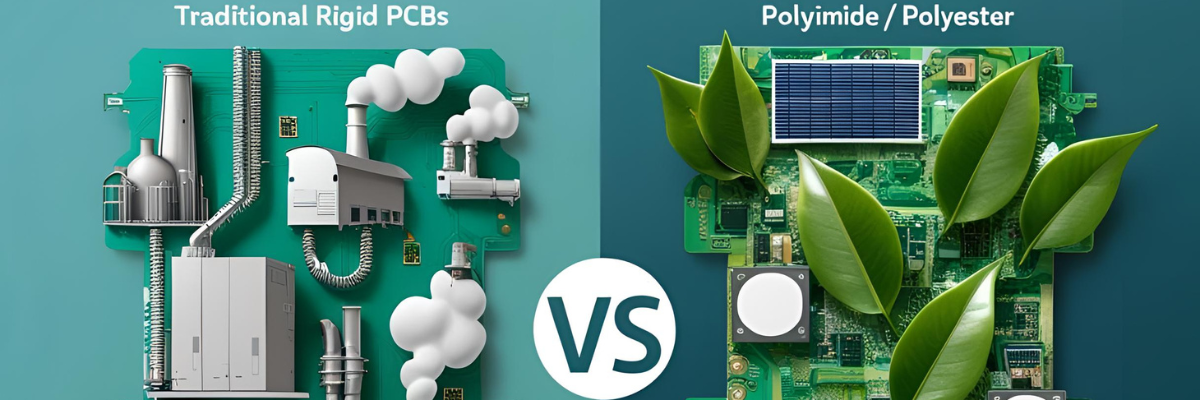As electronics continue to shrink and evolve, the demand for flexible boards has increased owing to the need for bendability. Also, the environmental impact of the components that power these boards has gained importance. Traditional rigid PCBs, while effective in terms of structural stability, contribute to energy consumption during manufacturing and may contain materials such as lead. Flexible boards can be made using recyclable materials such as polyimide and polyester, which are sustainable alternatives. With their lighter weight, reduced material usage, and eco-friendly substrates, flexible PCBs help create greener, more efficient electronics. In this post, we look at how flexible PCBs are better for the environment compared to their rigid counterparts.
What Are Flexible PCBs?
Flexible PCB substrates such as polyimide or polyester enable the boards to bend, twist, or fold without compromising their functionality. Also, these materials have better heat dissipation abilities compared to conventional substrates. These boards are used in a wide range of applications, from wearables and medical devices to automotive systems and smartphones.
By replacing or combining with rigid PCBs as per the requirement, FPCBs not only enable innovative and complex designs but also offer several environmental benefits, which we’ll explore further in this post.
Environmental Impact of Traditional Rigid PCBs
Here’s a breakdown of the environmental impact of rigid PCBs.
-
- Excess material waste: Rigid PCBs are made from materials like fiberglass, epoxy resin, and metals, all of which generate significant waste during production. The manufacturing process often involves cutting and shaping large sheets, resulting in leftover material. While metal portions can be reused, the other materials may not be ecofriendly.
- Difficult recycling: Once a rigid PCB reaches the end of its life, recycling it can be complex and costly. The layers of materials and the use of toxic substances, such as lead, make it hard to safely reclaim valuable metals and other components.
- High energy consumption: The production of rigid PCBs is energy intensive. The materials require high temperatures and specialized equipment to process, which contributes to high energy consumption and a large carbon footprint.
- Shorted lifespan in some cases: Rigid PCBs are often less durable in harsh operating environments and extremely elevated temperatures, leading to more frequent replacements. This not only wastes resources but also increases electronic waste (e-waste), a growing global problem.
How Flexible PCBs Help the Environment
Compared to rigid PCBs, flexible PCBs are more eco-friendly, and help to reduce waste, energy consumption, and environmental impact. Here’s how they contribute to sustainability.
- Less material waste: FPCBs are made with thinner, flexible materials that require fewer raw materials compared to rigid PCBs. Their can fit into compact spaces and hence the smallest of devices, with the required flexibility and functionality.
- Longer lifespan and durability: Flexible PCBs can withstand bending, vibrations, and harsh environments better than rigid PCBs, leading to fewer replacements and less electronic waste. Their durability extends the life of electronic products, reducing overall production demand.
- Easier recycling & reduced toxic waste: FPCBs often use fewer or no toxic materials, making disposal and recycling easier and safer. The reduced use of solder joints and connectors lowers the risk of hazardous waste contamination.
- Compact and lightweight design: With the shrinking size of devices, FPCBs eliminate the need for multiple rigid boards and contribute to smaller, lighter devices, without compromising on functionality.
Sustainability Benefits
Here’s how flexible PCBs contribute to a greener future.
- Improved recyclability: Flexible PCBs are generally made using recyclable plastics. Their reduced reliance on solder joints and connectors also simplifies disassembly and material recovery.
- Eco friendly applications: The lightweight and adaptable nature of FPCBs enables the development of energy-efficient devices, like wearables, medical equipment, and automotive electronics. They support sustainable technologies, including solar panels, electric vehicles, and smart devices designed for lower power consumption.
The applications of entirely rigid PCBs are now limited. Most applications require rigid-flex or total flexible boards. In many ways, flexible PCBs offer better fitment, convenience, and sustainability, and they find use in mission-critical applications as well. However, in most applications, rigid-flex PCBs still matter due to the need for structural stability along with flexibility. One can eliminate the use of toxic materials in rigid PCBs, such as making lead-free (ROHS-compliant) boards to make them ecofriendly. So, while flex boards do have advantages, we cannot write off rigid boards. As an OEM, if you require flex or rigid-flex board assembly in your upcoming product, you may want to consult an experienced PCB assembly services provider who also meets your sustainability goals. At Rigiflex, innovation and sustainability go hand in hand. As a trusted manufacturer of flexible and rigid-flex PCBs, we focus on delivering high-quality, reliable solutions that meet environmental and performance demands. To learn more about how flexible PCBs can benefit your applications, contact us today!
